Speech Some Effects of the New Liquidity Regime

Guy Debelle
[*]
Assistant Governor (Financial Markets)
28th Australasian Finance and Banking Conference
Sydney –
- Audio 14.92MB
- Q&A Transcript
Today I would like to discuss a few aspects of the liquidity regime that has been in operation in Australia for almost a year now, namely the application of one important aspect of the Basel III standards, the liquidity coverage ratio (LCR). I will describe some of the features of the LCR regime that have emerged over the past year and some of the market developments that have taken place since its introduction. I will also summarise some of the information that the Reserve Bank has gathered from a related development, the provision of detailed information on asset-backed securities. This information has resulted from the Bank's stipulation that for an asset-backed security to be repo-eligible in the Bank's operations, or to be usable collateral for the Committed Liquidity Facility (CLF), an issuer needs to provide loan-level data and detailed information on the security.
The LCR has been in full operation in Australia from the beginning of this year. In 2013, banks had a trial run, so a number of the balance sheet and other changes had already started to take place. Hence, by the time we got to the beginning of this year, all banks were meeting their LCR requirement, generally with a reasonable buffer. To remind you, the LCR requires that banks hold enough high quality liquid assets (HQLA) to cover their projected net cash outflows (NCOs) in a 30-day stress scenario. Banks are required to calculate and maintain an LCR of at least 100 per cent every day. In other words, absent severe market disruption, the LCR is to be met all the time, not just at the end of a quarter (say).
While banks undertake extensive modelling to project their cash flows, there is some inherent unpredictability and lumpiness in these flows, including around large deposits, as well as some derivative positions. As a result, all banks have decided to maintain a buffer above 100 per cent. To date, the average LCR for the industry has been around 120 per cent with some banks maintaining large buffers.[1]
To meet the LCR, banks have made changes to both the asset and liability side of their balance sheets. On the liability side, over the past couple of years, there has been little change in the aggregate shares of deposits and wholesale funding, but beneath the surface the changes have been much greater.
- Liabilities with high run-off rates under the LCR, such as deposits held by other financial institutions, have been repriced to reflect the fact that they are not particularly attractive forms of funding for a bank. The competition for this sort of deposit has not been particularly intense, indeed the opposite has often been the case, where banks have been happy to see these less sticky forms of funding leave.
- In contrast, the competition for deposits with low run-off rates has been particularly intense. Such deposits include those where a customer has a number of different products with the same institution, meaning their deposit is assessed to be stickier. Banks have been willing to pay up for these more stable forms of funding which has seen their relative rate rise.
- Term deposits are now actually ‘term’ deposits and are, for the most part, unbreakable ahead of the maturity date (without at least one month's notice). In the past, such deposits were often broken ahead of the maturity date with little or no penalty. Similarly, banks have made the pricing of notice-of-withdrawal accounts more attractive to savers, where the investor is required to give the bank advance notice of their intent to withdraw their funds.
- Banks have sought to increase the average maturity of their wholesale bond funding. The average maturity of outstanding wholesale bond funding has increased from 3 years to around 3½ years since 2011.
- There has been a marked decrease in the use of wholesale funding with a maturity of less than 30 days. This is a particularly unattractive source of funding for the banks, as they need to cover such funding with 100 per cent HQLA. Hence there is little incentive to offer a yield any higher than the yield on HQLA. This is evident in the yield on one-month bank bills. The spread between the one-month bank bill swap rate (BBSW) and OIS declined markedly at the beginning of the year (as I noted on an earlier occasion, this repricing was left to the last minute[2]) and has generally been low and stable since. At the one month maturity, we see more activity in banks buying back bills that have rolled down to a residual maturity of one month than we do of new issuance.
On the asset side, there have also been a number of changes. However, unlike on the liability side, many of these changes took place well ahead of the LCR coming into force at the beginning of this year. We haven't seen too many changes take place over the past year.
The most notable change has been the increased holdings of HQLA by banks. To remind you, securities eligible as high quality liquid assets in the Australian market are Commonwealth and state government paper. Because of the relatively small pool of government paper in Australia, the Reserve Bank provides, for a fee of 15 basis points per annum, a committed liquidity facility (CLF) to address the shortfall in HQLA that can be reasonably held by the banks.[3] Assets which can be used to access this facility are assets which are eligible collateral in the Bank's market operations, as well as selected securities which the RBA has exempted from certain aspects of its related party guidelines.
Graph 1 shows the increased holdings by banks of Commonwealth and state paper. The increased share since the end of 2012 is primarily a result of banks increasing their holdings in preparation for the LCR. Currently banks hold just over a quarter of the stock on issue. It is our assessment that if banks were to hold much more of the stock than this, liquidity in the market would run the risk of being impaired. While it is impossible to be too exact in determining where this (il)liquidity threshold is, we do not want to find out the hard way that we have set the required holdings too high and market functioning is impaired.
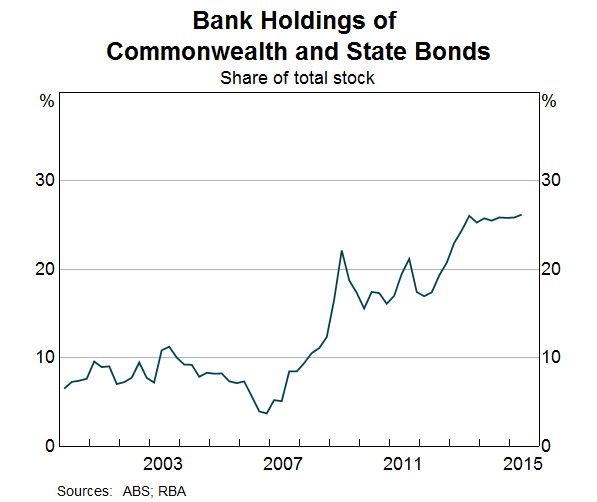
Within the overall share of government paper held by the banking system, the share held in state government paper is much higher than it is in the Commonwealth's paper. APRA maintains an ongoing discussion with banks about how they determine their asset allocation between the various forms of HQLA.
Government paper comprises around 40 per cent of banks' Australian dollar liquidity holdings. The CLF largely makes up the remainder of banks' available Australian dollar liquidity for LCR purposes (Graph 2). The size of a bank's CLF is determined by APRA each year as the difference between the banks' projected Australian dollar net cash outflows and the amount of HQLA that they can reasonably hold. Hence a bank's annually determined CLF will decline if either their projected net cash outflows decline and/or if the stock of HQLA increases. Over the course of 2015 both these developments have occurred. For 2015, the banking system's Australian dollar liquidity needs, in terms of their projected net cash outflows plus an appropriate buffer to ensure the LCR remains comfortably above 100 per cent, was assessed by APRA to be $450 billion, while we projected that the banks could reasonably hold $175 billion of HQLA securities. For 2016, system liquidity needs have fallen to $440 billion, even as banks' balance sheets have expanded. This is because banks have sought to reduce their net cash outflows by the adjustments to their liabilities I described earlier. At the same time, based on Commonwealth and state government budgets, we project that the stock of HQLA securities that the banks can reasonably hold will rise by $20 billion by end 2016. As a result the size of the 2016 CLF will decline from $275 billion to $245 billion.
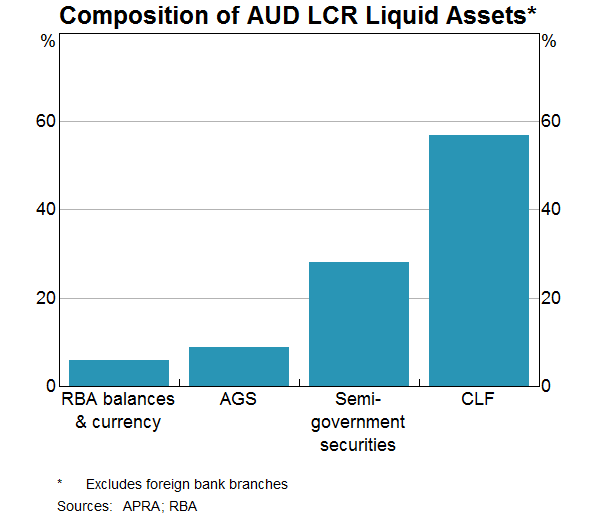
Graph 3 shows the composition of the CLF collateral that the banking system holds. Self-securitised assets comprise the bulk of the assets held. This is another area of ongoing discussion between APRA and the banks. Other assets held are primarily bank-issued paper. These assets are all held on the balance sheets of the relevant bank. They are not ‘pre-positioned’ or held on the balance sheet of the Reserve Bank, as is sometimes the case in other jurisdictions.
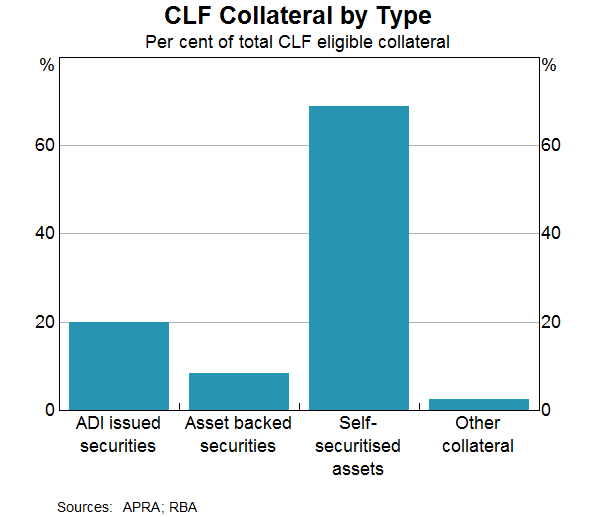
Moreover, the assets are subject to a haircut in terms of the amount of liquidity they can potentially generate. For example, the haircut on a self-securitised mortgage-backed security is typically more than 20 per cent, depending on various features of the security. That is $100 of such a security could potentially access no more than $80 of liquidity through the CLF. In contrast, $100 of an Australian government bond can be sold for $100 of cash.
While such assets generally reside on the balance sheet of an individual bank, in stressed circumstances, when the CLF is activated, the assets will be repoed to the Reserve Bank. To manage this contingent risk, it is very important that we have detailed information about the quality of such assets and are also able to price them accurately to determine the amount of liquidity we would potentially provide against them.
To enhance the information available to us, since the middle of 2015, mandatory reporting requirements came into effect for asset-backed securities to be repo eligible with the Reserve Bank and also to be eligible collateral for the CLF.
The required information includes key transactional level data, detailed tranche information, and the relationships between trusts and service providers including who is providing various facilities such as a fixed to floating swap. At the loan level, required data for RMBS include: 62 loan fields such as loan balances, interest rates, arrears measures; 18 borrower fields such as borrower income, employment type, whether they are an investor or owner-occupier, whether they are a first home-buyer; and 13 collateral fields (that is, detail on the collateral underpinning the mortgage) including postcode and property valuation.
These requirements include data that are commonly used by ratings agencies and RMBS investors, but the data go beyond that to also include some useful information that has not been commonly compiled before, such as offset balances and borrower income at origination. This allows us, along with other investors in asset-backed securities, to undertake a richer analysis of such securities and more accurately assess their risk and pricing than may have been possible before. In our case, it allows us to undertake our own risk assessment and not be dependent on rating agencies.
In addition to these data fields, issuers are also required to provide a working cash flow waterfall model of the security which can provide useful information about structural aspects of ABS in some cases only previously obtainable through a detailed reading of legal documentation. This innovation has been very useful in standardising information across securities, allowing us to verify structural features of deals and provide more granular haircuts and pricing than was the case previously.
These reporting requirements are standardised for all repo-eligible asset-backed securities, meaning that the same information is required for all securities. As a result, going forward, it will be easier to compare securities. We see this as being of great benefit to the industry as a whole, as does the industry itself, as evidenced by the support of the Australian Securitisation Forum (ASF) through the whole process of introducing these new standards.
The repo-eligibility requirements also direct issuers to make the information available to investors and other permitted users, not just to the Reserve Bank. By and large, the information provided to these groups is the same as that provided to the Reserve Bank; however, there have been some fields where the information provided posed a potential risk to privacy. Hence issuers may redact some particular fields and provide aggregated de-individualised data about these fields instead.
Since the middle of this year, we have received into our securitisation system around 1 600 submissions, covering around $400 billion in assets, including around two million individual housing loans. The information is updated on a monthly frequency so we are gaining not only a much richer view of the ABS market at any point in time, but also a rich time series. With this very large panel data set we can examine how the market, and the underlying collateral, evolves through time.
With the caveat that the data reporting is still in its infancy, it's already apparent that there are many potential benefits of the data. Let me illustrate some of the summary information that we can glean from the first few months of reporting. As noted earlier, these data cover around 2 million housing loans of the total of the approximately 6 million such loans on issue currently.
Graph 4 shows the loan to value ratio (LVR) at origination and currently. The largest share of loans had an LVR at origination of between 70 and 80 per cent. While that is still the case in terms of the current LVR, the share is noticeably lower. Similarly, there are almost no loans with an LVR greater than 90 per cent, even though around nearly 10 per cent had an LVR greater than 90 at origination. That said, it should be borne in mind that securitised loans tend to be more seasoned than non-securitised loans and are therefore amortising more quickly. The seasoning (time since loan origination) of the securitised loans is shown in Graph 5. It shows that 95 per cent of the value of loans is more than one year old, and nearly 75 per cent is more than three years old.
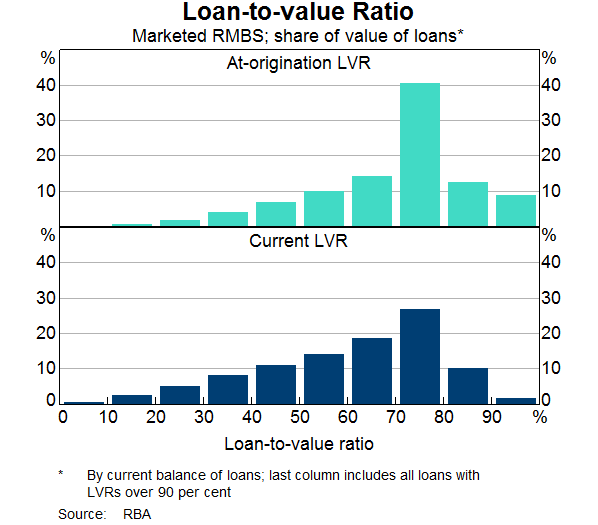
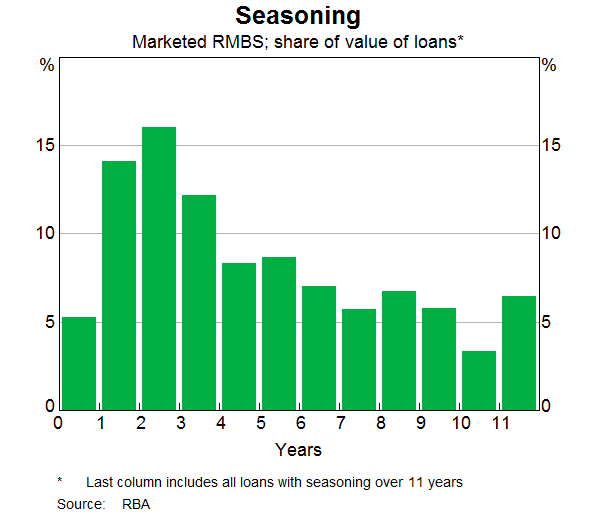
One issue which is of some interest currently is the extent of the repayment buffer that has been built up by borrowers. This is shown in Graph 6 which shows that two-thirds of borrowing is covered by a repayment buffer of at least one month's worth of required mortgage payments, and for half of this, that buffer is more than one year. As the time series on this loan feature accumulates it has the potential to be useful information for monetary policy as well as financial stability considerations. Graph 7 shows the level of documentation for loans securitised by different types of lender. It shows that the major banks have a minimal share of low doc loans in their pools, whereas for the non-bank issuers the share is considerably larger.[4]
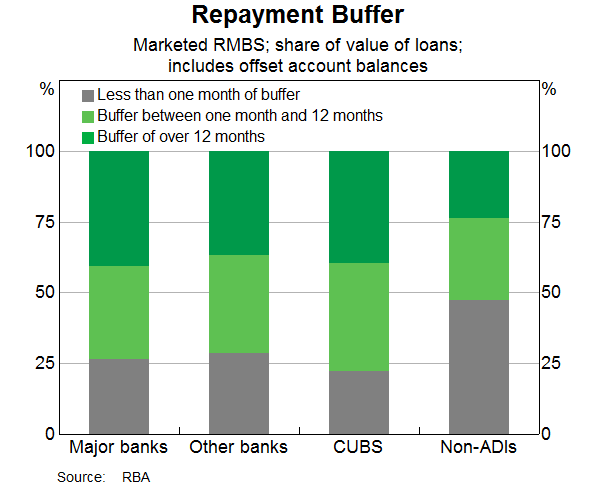
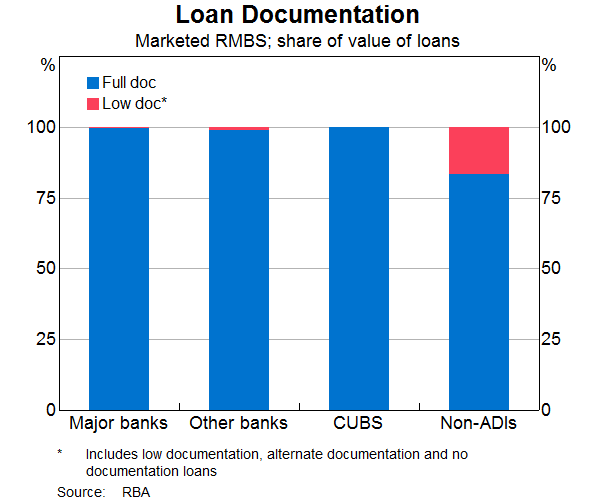
Finally, in terms of credit risks, Graph 8 shows arrears rates by states and shows that the current distribution of arrears are consistent with the variation in economic conditions across the states, though at the same time all arrears rates are relatively low.
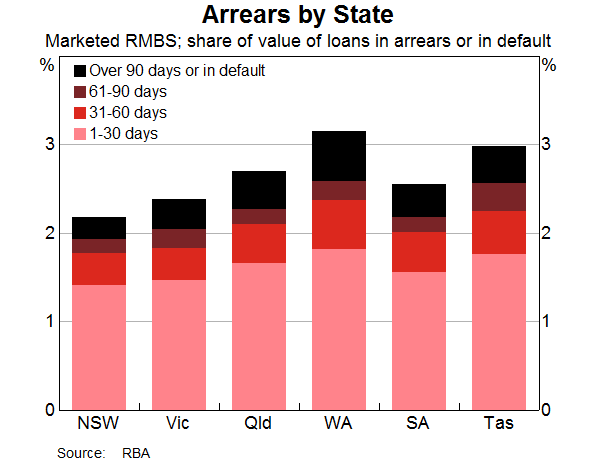
Of course, credit risk is not so much about the averages but the distributions. Having the loan level data enables an insight into the characteristics of the loans in the various tails of the distribution that warrant closer attention. It will also allow an assessment of the correlations between the various drivers of risk that may lead to credit deterioration.
In sum, there is very rich potential in these data for many purposes for the RBA and other market participants. From our point of view, the data provide us with a great deal of insight into the contingent risk that might at some point reside on our balance sheet. But clearly, the data are also very useful for financial stability and monetary policy considerations too.
Conclusion
To conclude, as we approach one year of the full implementation of the LCR in Australia, it is worth looking at some of the changes that have occurred. There has been repricing of liabilities to reflect the differences in their treatment under the LCR. On the asset side, there have been increased holdings of government paper. The banking system's contingent use of the CLF will decrease in 2016 from 2015 as banks have made adjustments to lower their net cash outflows, which increases their resiliency to funding shocks. This has occurred even as bank balance sheets have continued to expand.
While the LCR is now well established in the local market, the net stable funding ratio (NFSR) is yet to be implemented and APRA will be consulting on this next year. This is also likely to have an impact on the composition of bank balance sheets.
The enhanced reporting of information on asset-backed securities that commenced in the middle of the year is providing the Bank and market participants with a wealth of standardised information on this part of the market. It is allowing the Bank to enhance its risk assessment of its contingent liability under the CLF, by providing us with a very granular insight into the collateral that is held against the CLF. The data are beneficial not only for this reason but also have the potential to inform assessments of financial stability and provide insight into one important transmission channel of monetary policy.
Endnotes
Thanks to George Gardner, Tai Lam, David Wakeling and Kelsey Wilkins. [*]
Banks are required to publicly report information on their LCR on a regular basis. [1]
Debelle G (2014), ‘Liquidity’, Address to the 27th Australasian Finance and Banking Conference, 16 December 2014. [2]
The 15 basis points is the annual fee. In the event, the CLF is drawn on a 25 basis point rate is charged. The all-in cost of the facility also needs to take account of the haircut applied to collateral used for the CLF discussed below. [3]
Though the latter have other features which provide increased credit support. [4]